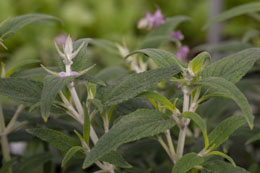The perfect purple flowering plant for summer and fall gardens, Mexican sage is a hardy, evergreen perennial bush. Even in droughts, this sage produces beautiful flowers. This article explains what a Mexican sage is, its classification, and how best to grow one in your garden.

Neither a true shrub nor herbaceous, the Mexican sage plant is identified as a subshrub. The plant height and spread measure about 2-4 feet at maturity. It is perennial in growth pattern, and grows as an evergreen plant in warm climatic conditions. When grown in areas where the temperature is extremely cold, this plant dies in the winter and grows back in the next growing season.
What is it?
As the name goes, the Mexican sage plant is indigenous to Mexico and parts of South America. Today, it is cultivated as a popular flower garden plant in many parts of the world. The family name is
Labiatae, comprising about 500 sage species. While the accepted scientific name is
Salvia leucantha, it is known by varied common names like 'velvet sage' for its velvety calyx. With respect to its bushy growth habit, this plant is also known as Mexican bush sage.
The individual leaves of this sage are lanceolate (about 2.5-12.5 cm in length). The upper surface of the leaf is green, while the surface underneath is covered with fine hair, giving it a whitish color. The stem is angular―a common character of all sage species―with a herbaceous top portion, but the lower stem section is somewhat wood-like in hardness and texture. With the arrival of summer, small flowers in shades of white or purple (depending on the species) are developed on the twigs.
Procedure for Growing
Similar to common sage plants and other species of the
Salvia genus, the Mexican sage possesses special features that contribute to its popularity as one of the most preferred garden shrubs and bushes. Best grown in USDA zones 7-11, one thing to be noted with this bush is a low tolerance for waterlogged conditions. Hence, planting in well-drained soil is a prerequisite for maintaining disease-free sage bushes.
Propagation
Propagation of this flowering plant is done from seeds and stem cuttings (both the younger portion and the woody stem). For the first mode of propagation, the flowers are allowed to stay on the plant until faded, then the seed heads are collected. Harvesting can be done at any time of the year, but spring is preferred. If you are a beginner, you can purchase healthy plantlets from your local nursery center.
Growing
The ideal time for planting this flowering plant is spring. For growing outdoors, select a sunlit area. Potted plants can be kept in a sunny patio, or near a window. Prepare garden soil or potting soil that is well-drained and near neutral pH range. Make holes that are slightly larger than the root ball, and place the sage plantlets. Fill soil in the holes and water them deeply to ensure quick establishment.
Care
Once established, this sage bush requires low maintenance and performs well even when it is left unattended for some time. The best part is its resistance to drought conditions. Water them only when the top soil is dry. Less watering is better than over-watering. In standing water, these plants are susceptible to root rot and mildew disease. You can feed them with a dilute liquid fertilizer in spring and mid summer.
Pruning
Pruning a sage plant is necessary to maintain proper shape and promote growth of new branches. In absence of annual trimming, this plant becomes more elongated rather than being bushy. There is no need for removal of twigs other than for shaping. During the peak blooming period, you can pinch off the spent blooms. This will not only result in bushy growth, but will increase the blooming period of the garden grown bushes as well.
In the blooming season, you will get to enjoy lovely flowers with frequent visitors like bees, butterflies, and hummingbirds. The flowering stalks have a long shelf life and are frequently used as cut flowers. The purple-colored petals retain their original color even after drying, thus making wonderful dry flowers for decoration.






 Neither a true shrub nor herbaceous, the Mexican sage plant is identified as a subshrub. The plant height and spread measure about 2-4 feet at maturity. It is perennial in growth pattern, and grows as an evergreen plant in warm climatic conditions. When grown in areas where the temperature is extremely cold, this plant dies in the winter and grows back in the next growing season.
Neither a true shrub nor herbaceous, the Mexican sage plant is identified as a subshrub. The plant height and spread measure about 2-4 feet at maturity. It is perennial in growth pattern, and grows as an evergreen plant in warm climatic conditions. When grown in areas where the temperature is extremely cold, this plant dies in the winter and grows back in the next growing season.